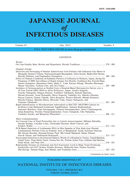Volume 67, Issue 1
Displaying 1-16 of 16 articles from this issue
- |<
- <
- 1
- >
- >|
Original Article
-
Article type: Original Article
2014Volume 67Issue 1 Pages 1-4
Published: 2014
Released on J-STAGE: January 22, 2014
Download PDF (138K) -
Article type: Original Article
2014Volume 67Issue 1 Pages 5-8
Published: 2014
Released on J-STAGE: January 22, 2014
Download PDF (98K) -
Article type: Original Article
2014Volume 67Issue 1 Pages 9-16
Published: 2014
Released on J-STAGE: January 22, 2014
Download PDF (6470K) -
Article type: Original Article
2014Volume 67Issue 1 Pages 17-21
Published: 2014
Released on J-STAGE: January 22, 2014
Download PDF (126K) -
Article type: Original Article
2014Volume 67Issue 1 Pages 22-26
Published: 2014
Released on J-STAGE: January 22, 2014
Download PDF (146K) -
Article type: Original Article
2014Volume 67Issue 1 Pages 27-32
Published: 2014
Released on J-STAGE: January 22, 2014
Download PDF (219K) -
Article type: Original Article
2014Volume 67Issue 1 Pages 33-39
Published: 2014
Released on J-STAGE: January 22, 2014
Download PDF (115K) -
Article type: Original Article
2014Volume 67Issue 1 Pages 40-43
Published: 2014
Released on J-STAGE: January 22, 2014
Download PDF (106K)
Short Communication
-
Article type: Short Communication
2014Volume 67Issue 1 Pages 44-46
Published: 2014
Released on J-STAGE: January 22, 2014
Download PDF (80K) -
Article type: Short Communication
2014Volume 67Issue 1 Pages 47-49
Published: 2014
Released on J-STAGE: January 22, 2014
Download PDF (235K) -
Article type: Short Communication
2014Volume 67Issue 1 Pages 50-53
Published: 2014
Released on J-STAGE: January 22, 2014
Download PDF (100K) -
Article type: Short Communication
2014Volume 67Issue 1 Pages 54-57
Published: 2014
Released on J-STAGE: January 22, 2014
Download PDF (1924K) -
Article type: Short Communication
2014Volume 67Issue 1 Pages 58-61
Published: 2014
Released on J-STAGE: January 22, 2014
Download PDF (161K) -
Article type: Short Communication
2014Volume 67Issue 1 Pages 62-65
Published: 2014
Released on J-STAGE: January 22, 2014
Download PDF (214K)
Laboratory and Epidemiology Communications
-
Article type: Laboratory and Epidemiology Communications
2014Volume 67Issue 1 Pages 66-68
Published: 2014
Released on J-STAGE: January 22, 2014
Download PDF (1397K) -
Article type: Laboratory and Epidemiology Communications
2014Volume 67Issue 1 Pages 68-70
Published: 2014
Released on J-STAGE: January 22, 2014
Download PDF (3638K)
- |<
- <
- 1
- >
- >|
